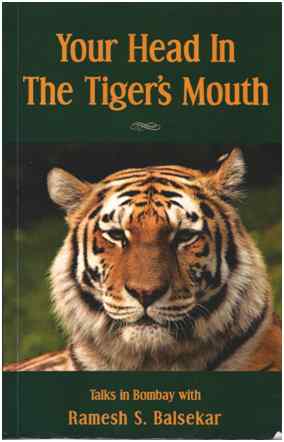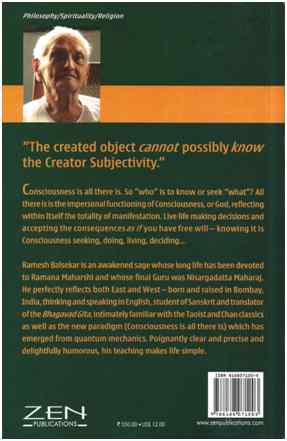 |
YOUR HEAD IN THE TIGER’S MOUTH
Book Review by Vikas Shukla
Details of the book
| Title |
Your Head In The Tiger’s Mouth (Talks in Bombay with Ramesh Balsekar) |
| Editor |
Blayne Bardo |
| ISBN 10 | 81-8807120-X |
| Publishing Date | 1998 |
| Publisher | Zen Publications |
| Pages | 428 |
| Language | English |
| Price | Rs. 550 US$ 12.00 |


Review
“Your Head is already in the Tiger’s Mouth. There is no escape” is a statement attributed to Ramana Maharshi, the great saint of our times, who spent most his life in the proximity of his beloved Mount Arunachala in the holy town of Thiruvannamalai. These words have been and continue to be succour and consolation for many a seeker in his hour of despair and hopelessness. They resonate with hope and a promise of deliverance, and remind the seeker of the unfailing arrow of destiny.
The book Your Head In The Tiger’s Mouth is a collection of talks with Ramesh S. Balsekar (1917 - 2009), recorded at his residence in Mumbai. Ramesh worked in an Indian nationalized Bank and retired as its President in 1977. After his retirement, Ramesh met his Guru, Sri Nisargadatta Maharaj, the well-known Advaita master. On instructions from his master, Ramesh himself began teaching in 1982 and started holding satsangs in his flat in South Mumbai. Ramesh also wrote more than 25 books. He was regarded as a contemporary sage and a householder Guru. Ramesh was a devotee of Ramana Maharshi, whose teachings he had imbibed and lived. This book is the result of Ramesh’s wish to share his talks, with other seekers in the world.
Ramesh had insisted that the book opened with Blayne Bardo’s autobiographical account of his journey of seeking. It is indeed a fascinating tale of spiritual highs, irreparable reversals, hours of despair, moments of hope and a homecoming. It is, as Blayne Bardo calls it, a ‘bitter sweet journey’ and sets the agenda for the rest of the book.
The main book is set out in fifteen chapters or ‘scenes’, as the editor calls them. The setting for each scene is the same: a small room in Ramesh’s flat, a number of seekers, some silent, others full of questions, and Ramesh. The reader finds it easy to relate to the questions and comments of the attendees and get drawn into the conversation.
Often, one gets the feeling of being led away from the familiar ground, away from one’s past beliefs and all that one may have read, learnt or practiced. Fear and doubts begin to gather in one’s mind. However Ramesh continues to hold your hand firmly in his and lead you up the trail. He reminds you of Ramana Maharshi’s words, “There are various ways of getting to the top of a hill.” The top of the hill is the real destination, the path is merely a concept to be used and discarded.
Readers are treated to the rare sight of a true master in action. With his probing questions, the challenges, the deliberate repetitions, the encouraging pat on the back and the gentle reprimand; it is easy to visualise Ramesh as a rishi in his ashram, surrounded by his disciples.
The ‘scenes’ are meant to follow broad themes. However conversations with Ramesh are always free-flowing, encompassing a wide range of topics. The reader has to quickly get used being in a conversation that could begin with the topic of the ego and end in a discussion on Quantum Mechanics. The remarkable thing is that the thread of conversation never breaks and one thought just melts into another. Ramesh also uses a vocabulary of his own, where words such as ‘concept’, ‘Truth’, ‘God’ and ‘ego’ take on different meanings. The glossary provided at the end of the book comes to the aid of the first-time reader.
Each ‘scene’ ends with a little treat; an English translation and transliteration from Marathi of the Abhang sung at the end of the satsang. They provide the perfect ending to the day’s deliberations.
The first ‘scene’opens to a light-hearted conversation in progress between Ramesh and some newcomers, which soon leads into a discussion on concepts, personal effort, intellectual Understanding and Acceptance. Ramesh offers a simple but potentially explosive definition ofa concept, “…whoever has said anything is a concept – concept being something that some people may accept, some people may not.” On applying this test, the listener is hit with the realisation that Consciousness, Energy, Source or God is the only Universal Truth. The rest, including Ramesh’s own teachings, are all concepts! Ramesh unveils the core of Advaita with the words, “What are you seeking [Nina]? You are that Truth. The only Universal Truth you are. You are That. So if you are the Universal Truth, what are you seeking?” and “All manifestation is a reflection in the Source – otherwise, there would be two.”
The next few ‘scenes’ lead the students into the depths of discussions on ego, involvement, love and impersonal love, personal doership, Divine Hypnosis, prayer, manifestation and programming. Like a weaver weaving an intricate design, Ramesh leads the discussion in and out of concepts with practiced ease and dexterity, unravelling on the way, with immense patience and care, the listeners’ mental knots and entanglements. The discussion turns to the question of needing a Guru, and Ramesh clarifies, “The Guru is merely a mechanism in phenominality for this [Understanding] to happen. For the grace to flow, the Guru is the mechanism…When the seeking begins the Guru is not necessary. For the seeking to progress, the Guru is necessary and whether you get a Guru or a suitable Guru will depend on the destiny of the mind-body organism.”
The curtain rises on the next ‘scene’ to show a visitor in conversation with Ramesh on his personal experience of the teachings of Bhagavad Gita. Ramesh begins to gently explore the depth of the visitor’s understanding, which blossoms into a full-fledged enquiry into the core teachings of Lord Krishna. Starting with why Arjuna felt the way he did, to what did Krishna actually tell him to make him pick up his bow and arrow, it is an absorbing conversation and a delight to read. The conversation is studded with powerful statements. “Basically a person [Arjuna] is concerned with guilt: ‘I have done something I should not have done’ – therefore he feels guilt. But if he truly understands that there is no action which he can do, that there is no action any human being can do – where is the guilt?” “The created object cannot understand the Creator Subjectivity. Therefore you can only accept God’s will – you cannot understand God’s will” and the most potent “So, when that final Understanding happens, the object ceases to seek because the seeker is no longer there.”
What follows is brief but illuminating discussion on the Upanishads with Ananda Woods, a physicist and Upanishad scholar. Together they explore the basic nature of the Upanishads and test some of the core principles of Advaita. The discussion spreads out to include Nasadiya Suktam from the Rig Veda, the Bhagavad Gita, the teachings of Tukaram and the story of Ramakrishna.
Ramesh starts the next session by referring to an exchange between Einstein and Niels Bohr where the latter replies to Einstein’s comments about God playing dice by pointing at Divine will, “God is not playing dice with the universe. You think God is playing dice with the universe because you don’t have all the information God has.” Ramesh poses the question “A thought arises, a desire arises and it takes a split-second for the brain to react to it and for the mind-ego to take possession and say that this is ‘my’ thought, ‘my’ desire…Now, you tell me whether the desire is of the ego or the Consciousness?” Ramesh then proceeds to shake up yet another common notion about giving up desire, “The only way desire can be surrendered is if you accept that this is not ‘your’ desire.” Believing that ‘you’ are giving up ‘your’ desire will only feed the ego.
He offers a few pointers for surrender: “Being in the Present Moment is Acceptance, is Surrender, because being in the Present Moment, there is no ego, no thinking mind…The thinking mind, the ego hides the Present Moment…It is only the ego that is concerned with the future. God is not concerned with the future. God is the Present Moment.”
Taking a cue from a comment by a student, Ramesh explains the concept of ‘Who Cares’, “Who Cares is not about life in phenomenality. Who Cares means: Who cares whether God is taking me along the path quickly or slowly – who cares? That’s his business. This attitude has got nothing to do with practical living”To a question about motivation in the competitive world Ramesh replies, “Motivation is merely a fiction created by the individual sense of doership: the individual sense of doership that I am in control of ‘my’ life; ‘I’ am doing things and in order to do things, ‘I’ have to be motivated.” He asks, “Assuming that there is no motivation, will the Energy not continue to function?” He continues to press home the point with the statements, “You have no control over what thoughts will come in your head. You have no control over what you are going to see or hear. The brain reacts to that event according to the programming over which you have had no control, and that reaction of the brain, that mechanical reaction of the brain, is what you call ‘your’ action…Identification is the ego which is brought about by God’s hypnosis, the Divine Hypnosis, God’s Lila. And That which has created the ego, wants in some cases to get rid of it. This is the whole problem for the apparent seeker – only that Power which has created the hypnosis can get rid of it.” Ramesh then throws in the most complex concept of all, “So the final understanding is that there has never been an entity. There never has been a seeker. There never has been a doer.”
This book of fifteen ‘scenes’ is followed by a collection of students’ letters to Ramesh. These are uninhibited outpourings of love for the master, each a tribute of affection and gratitude, served straight from the heart.
Two more little treats await the readers. One, a selection of verses on Advaita from the Bhagavad Gita and the other, a little story called ‘Who Cares’.
Despite the modern setting and vocabulary, Ramesh’s teachings areAdvaita delivered in its purest form. He wastes no time in demolishing the students’ misconceptions or invests any effort in sugar-coating the pill. This book is a pleasure to read.
For a ripe student, there could be enough in the book for ‘Acceptance’ to happen. For others, there would be enough to let through the first trickle of understanding. If at first you don’t grasp everything, don’t be discouraged; your head is already in the tiger’s mouth. It is only a matter of time.
|
 |